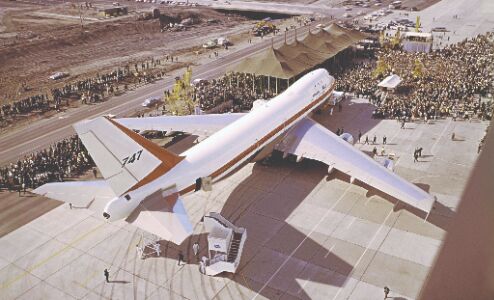Death of a Legend
Quietly and largely unnoticed, a giant has flown into the dusk and disappeared — for good, never to return, thanks to COVID-19 and the changing world airline order. A game-changer and heart-throb in its times, this glamorous behemoth changed the way the world travels. Now, we mourn, yet celebrate the Jumbo Jet

Some 50 years back, two best friends went fishing in a quaint lake in the United States. One of the two, the owner of Pan Am (Pan American Airways) challenged the other to build the world's biggest airliner, more than two-and-a-half times the size of any existing airplane of the time. The other, an accomplished plane-builder and the chief of Boeing Commercial Airplanes, said it couldn't be done, as it just wouldn't fly, with all that weight and drag. Nothing that humungous could ever take off the ground and stay in the air, he insisted. But the PanAm chief told the Boeing head, "Build it. I will buy it. I'll buy it, if you'll build it."
The Jumbo Jet was born. These were times mankind seemed unstoppable.
Thus, while fishing, went the conversation between American commercial aviation pioneer and the founder of Pan American Airways Juan Terry Trippe and then Boeing chief William McPherson 'Bill' Allen. While no one knows whether they caught any fish that day, they did end up launching the Jumbo Jet some five years later. Of such small conversations, then, are impossible dreams and missions born, and turned into unlikely reality. For five decades now, the Boeing 747 has been the most popular aircraft to take to the skies, ever, with both airlines and passengers. It made its first scheduled flight with Pan American Airways in 1970 and remained in production and in service, ever since. In these 50 years, there have been many variants since the original 747-100 was born. The 747-200 improved on engine issues with the first version, the 747-300 stretched the upper deck, and the 747-400 improved the engines and range and became the most sold version.
As Juan Trippe's son Ed Trippe says today, "My father wanted to develop new markets and get more people into aircraft as they could afford it. He did it. He made it possible. Nobody believed a second deck could be added, but my father wore them down."
The Jumbo happened, and ruled for decades. And then, COVID-19 happened and killed this legend.
It ruled. It has fallen
For half-a-century, the 500-seat, man-made giant fondly called the Jumbo Jet roamed the skies and ruled the planet. But today, airlines, with their shrinking numbers and very future at stake, have realized that the Jumbo Jet does not have a place in that tomorrow. The Jumbo Jet once opened up the world. Today, 50 years later, COVID-19 has written the final chapter and all but shut it down. And sadly, the Jumbo Jet has moved from 'Flagship' to 'Scrapyard'. Take a look at these basic numbers, as quoted in a recent BBC report – British Airways is scrapping its entire fleet of 31 Jumbo Jet 747s. KLM, Virgin and Qantas are also saying goodbye. Others are at the cusp of following suit.
As things stand today, airlines globally do not anticipate any significant surge in long-haul passenger traffic increase around the world till 2025, at the very least. Therefore, there is no prudence in maintaining and flying large aircraft such as the 747 in these five years. So off to sudden and unexpected death they have all been sent; sent with tears to Mojave Desert in the United States, the bone-yard where commercial airplanes go to die.
And such has been the love for this aircraft that the pilots who flew them for the last time turned on the engines and took off in tears, taking crew members with them in "our large empty aircraft that had vacant seats as far as the eyes could see". Upon landing, pilots, flight attendants, stewardesses and maintenance workers took turns to switch off engines, flaps and other electronic equipment on board, and then wept.
The first take-off
Enough of sob stories... Let's celebrate the giant of the skies. Unbeknownst to most, the first official commercial flight of the world's and Pan Am's first Jumbo Jet was a complete mess-up. This was a flight from New York to London. Within minutes of takeoff, passengers (who were anyway worried, scared of travelling in such a large aircraft that most critics said "could not fly" and compared it to the Titanic) noticed smoke and flames coming out of one engine. The aircraft had four engines and was fully capable of flying safely with even just one functioning properly, but hearing shouts of alarm from the passenger area, the pilots turned the Jumbo back and landed. Years later, those in the know revealed that they found molten metal in the tail-pipe.
As luck would have it, there was another swanky new Pan Am jumbo Jet at the same airport, one on which the painters were still working on in the hangar, stencilling in the company logo. Passengers were disembarked from the aircraft, sent to the airport lounges, served tea and muffins. The second plane was quietly rolled out and put into place for boarding. With trepidation and none-the-wiser, the passengers re-boarded their "same" flight, seven hours late. Immediately upon takeoff, literally with wet paint on the fuselage, the passengers were quickly served champagne. While in the air, all travellers experienced the world's first in-the-air lounge on the upper deck, had a drink or two or more there, smoked whatever they smoked, and chatted and giggled for hours while cruising over the Atlantic. Quietly, the Jumbo
Jet flew on and equally quietly, it safely landed without further incident. All passengers got off gaily, without a worry
in the world – no one knew the aircraft they arrived on in London was not the same one they initially took off from in New York.
The Jumbo Jet was born. It never looked back. Since that eventful first flight in 1970, it has carried over five billion people around the planet. Boeing spent USD 1 billion in developing and building the Jumbo Jet, and it paid off. It bet the company on it, and it won.
We just want to get there
And the Jumbo Jet is not the only iconic plane to have no place in our lives anymore. Other aircraft like the Airbus A380 are also being retired, cast aside. The only difference is that because they are almost all-new, recently introduced, airlines are spending some money in parking a few of them and maintaining them for later use, as and when needed. The Jumbo Jet's death comes just weeks after English aviation consultant Andrew Charlton said in UK's Daily Mail: "You will never see a (Jumbo Jet) 747 flying again, and the only A380s will have Emirates painted on the side."
That's because airlines, given today's changed travel scenario and trends, are increasingly focusing on lighter aircraft and fewer journeys, leaving no room for huge carriers, which were invented with the sole intention of making flying cheaper, widespread and more fun. But in a near-death situation as ushered in by the COVID-19, who wants fun anymore while travelling? We just want to get there and be out of the aircraft.
So what happens in Mojave, the bone-yard, graveyard, et al? Well, the engines are taken off first and sent back to the home country for re-use. Then, it is the turn of the wings and most of the fuselage, which are all crushed for recycling. Even here, sadly, there is no great payback, because scrapping is so common that the selling price for recyclable metals is at an all-time low. Whatever's left is left out in the desert, in the open, and lucky Americans in their big pickup trucks get to feast on the roost.
There is one new market, though. An increasing number of Americans are buying slices of retired Jumbo Jets with a few seats, like slices of a pepperoni pizza, to adorn their lawns and porches.
It couldn't go into space
The one thing the Jumbo Jet could not do, sadly, was go into space. That would have been classic and perhaps scared away any aliens headed to Earth to take over our planet, for who could take on a 400-tonne gargantuan aluminium tube with 500 raucous, inebriated humans on board, all of them laughing their guts out?
At last count, aviation experts and analysts also appear traumatized, as they fester over when and whether they will ever see or fly in another double-decker plane?
PS: A fully-functional and serviceable Jumbo Jet is available on eBay. The going price is USD 300 million. You may want to consider it carefully, especially since if you do end up buying it, you would be whisked away to your chosen destination in the same aircraft that the President of the United States (POTUS) does. Yes, Air Force One is a Jumbo Jet.
The writer is a communications consultant and clinical analyst. [email protected] Views expressed are personal



